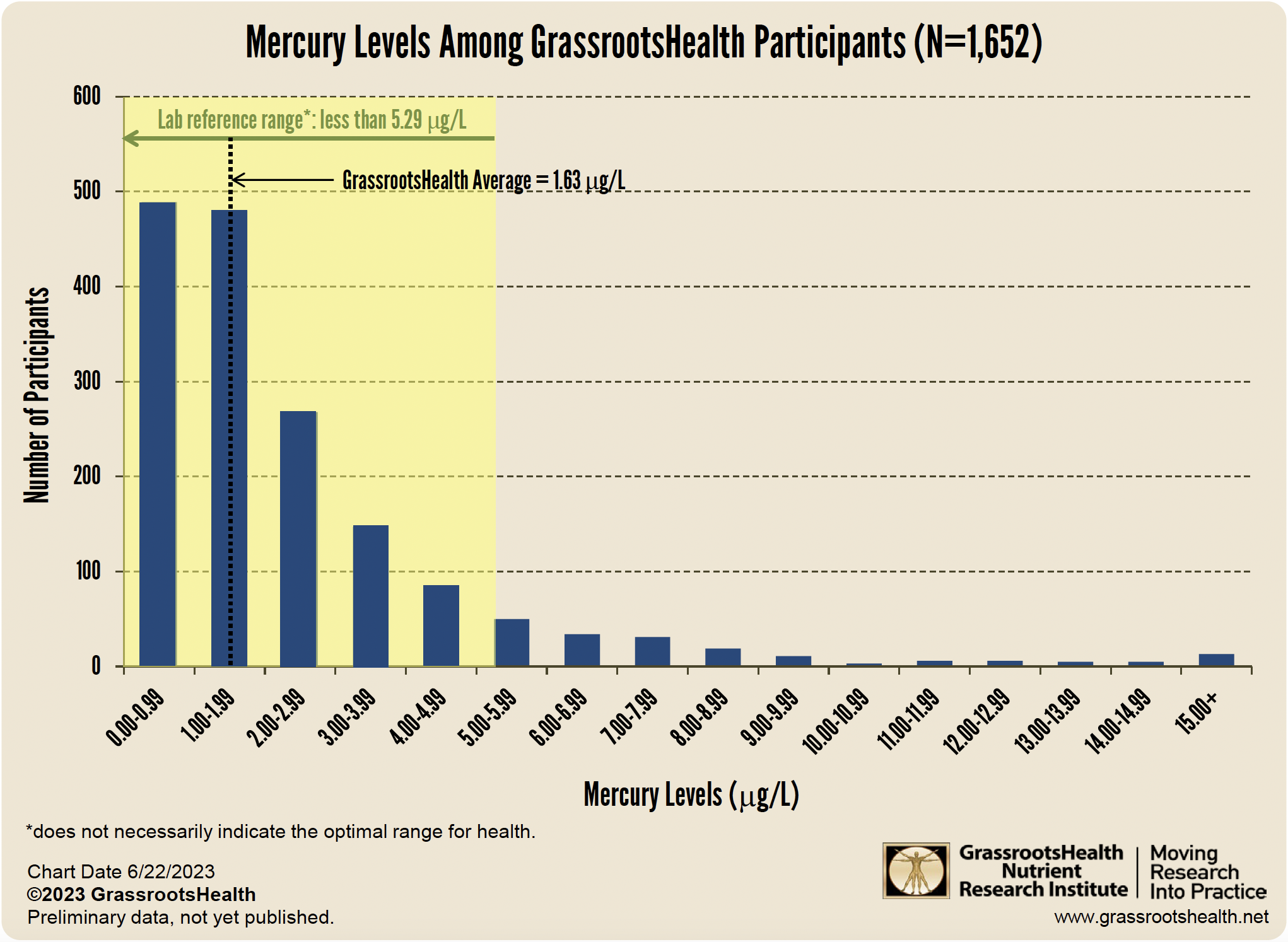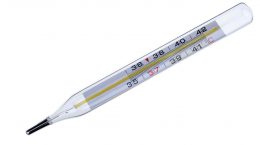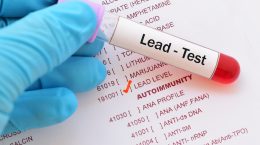Published on December 20, 2023
Mercury is a highly toxic heavy metal that can collect in and cause damage to the body’s tissues, especially the brain; it can also cause selenium deficiency, leading to diseases such as thyroid disease… are you being affected by mercury toxicity?
Key Points
- Mercury is a highly toxic heavy metal that can collect in the body’s tissues, especially the brain, where it can cause damage to the nervous system; high levels are associated with paresthesia, mood changes, sensory disturbances, renal toxicity, respiratory failure, and even death. It can also bind to it and reduce its biological availability, leading to diseases caused by selenium deficiency, such as thyroid disease.
- 11% of GrassrootsHealth participants had mercury levels above the reference range cut-off; among participants who completed at least two mercury tests, around half (51%) lowered their mercury levels after their first test
- If you suspect the mercury is coming from a supplement, you could change products, or go off it for 30 days and then retest for mercury; the test should be taken at least 48-72 hours after eating high mercury foods, such as certain types of fish or sushi
- Save 15% when including the Full Elements Panel in your test kit with code ELEMENTS15, now through 12/22/23
Add the Elements Panel to Your Home Test Kit Here
 Toxic elements, such as lead, cadmium, and mercury, have no known nutritional benefit and are known to interfere with proper functioning of proteins, lipids, and DNA within the cells. They can also interfere with essential elements by blocking their availability within the body. Toxins can contribute to the development of chronic diseases, making detoxification an important step towards healing and health, as briefly discussed by Dr. Richard Cheng in a recent post here.
Toxic elements, such as lead, cadmium, and mercury, have no known nutritional benefit and are known to interfere with proper functioning of proteins, lipids, and DNA within the cells. They can also interfere with essential elements by blocking their availability within the body. Toxins can contribute to the development of chronic diseases, making detoxification an important step towards healing and health, as briefly discussed by Dr. Richard Cheng in a recent post here.
The Full Elements panel offered by GrassrootsHealth measures the levels of essential elements magnesium, copper, selenium and zinc, as well as toxic elements lead, cadmium and mercury. We recently reviewed an updated analysis of lead results among GrassrootsHealth participants and cadmium results among GrassrootsHealth participants. Below is a summary of the latest analysis of mercury levels among GrassrootsHealth participants, completed in June of 2023.
What are the Health Effects of Mercury Toxicity, and Where does it Come From?
Mercury is a highly toxic heavy metal that can collect in the body’s tissues, especially the brain, where it can cause damage to the nervous system. High levels of mercury are associated with paresthesia, mood changes, sensory disturbances, renal toxicity, respiratory failure, and even death. Since mercury has a high affinity to selenium, it can also bind to it and reduce its biological availability, leading to diseases caused by selenium deficiency, such as thyroid disease.
While some people are exposed to mercury as an occupational hazard, most mercury exposure is due to consumption of fish and shellfish that contain methylmercury. Types of fish with the highest mercury concentrations include king mackerel, shark, swordfish, and tuna. A complete list of mercury levels in different types of fish and shellfish can be found here.
Organic mercury in the form of ethylmercury can also come from multi-dose preparations of vaccines containing the preservative thimerosal, such as some flu vaccinations.
The dried blood spot test is an indicator of recent exposure to organic mercury (methylmercury or ethylmercury), which has a half-life of around 70 days in the blood. Other types of mercury include elemental mercury (found in batteries, thermometers, and dental amalgams), and inorganic mercury (found in mercuric chloride and skin-lightening creams). The dried blood spot test for mercury will include minimal amounts of elemental mercury ; it will not include inorganic forms of mercury, nor will it show the amount of kidney burden from such types of mercury. A urine test is a better indicator of levels of these types of mercury.
What are Mercury Levels Among GrassrootsHealth Participants?
Among the 1,652 participants who have tested their mercury levels, the average level was 1.63 μg/L, which is slightly higher than our last calculated average (from June 2020) of 1.52 μg/L. While a vast majority had levels within the lab reference range (less than 5.29 μg/L), 11% had a level above the reference range cut-off; this reference range indicates the range of typical results found in the population the lab serves but does not necessarily indicate the optimal range for health.
Additionally, 276 participants had completed at least two mercury tests. Among these participants, around half (51%) lowered their mercury levels after their first test.
What can you do if your blood spot mercury result is high?
After looking at the sources of mercury mentioned above, you might be able to figure out where the mercury is coming from so you can take steps to decrease exposure. For example, the high mercury result could be related to a fish oil supplement (one that has not been molecularly distilled or vigorously tested for heavy metals), or it could have come from a “one time” source, such as a flu vaccine within a few days prior to the test, or a meal of sushi or fish high in mercury the night before. If you suspect the mercury is coming from a supplement, you could change products, or go off it for 30 days and then retest for mercury. The test should be taken at least 48-72 hours after eating high mercury foods.
Selenium May Help Protect Against the Toxic Effects of Mercury
In addition to identifying sources of mercury, being aware of selenium status is also useful. Selenium can help protect against mercury toxicity by binding to mercury and reducing its bioavailability, so it is important to make sure selenium levels are within a healthy range, especially with a high mercury level. A measurement of selenium is included in the Full Elements panel, which you can add to your custom test kit here.
Need help eliminating some of these toxic metals? Learn more about Heavy Metals and the Power of Detoxification.
Methods of detoxing or chelation for mercury are available, however, it is best undertaken with the help of a doctor who is familiar with the process, as it does have some risks. A good place to begin looking for a qualified practitioner is the American College for Advancement in Medicine (ACAM).
Make sure you are not being over exposed to the toxic elements mercury, cadmium and lead, and that you are getting enough protective minerals magnesium, selenium, copper and zinc! Measure your levels of each by adding the Elements Panel to your next GrassrootsHealth home test kit.
Add the Elements Panel to Your Home Test Kit Here
(Save 15% with code ELEMENTS15 now through 12/22/23)
Test Your Mercury Level as Part of the Elements Panel
 Measuring your level of lead and other toxic elements can help determine if you and your loved ones are being exposed, and if steps need to be taken to decrease that exposure and build-up in the body. Decreasing toxic elements while having and maintaining healthy levels of essential elements, vitamin D, and other nutrients can help improve your health now and for your future. Choose which to measure, such as your vitamin D, omega-3s, and essential and toxic minerals including magnesium and iron, by creating your custom home test kit today. Take steps to improve the status of each of these measurements to benefit your overall health. You can also track your own intakes, symptoms and results to see what works best for YOU.
Measuring your level of lead and other toxic elements can help determine if you and your loved ones are being exposed, and if steps need to be taken to decrease that exposure and build-up in the body. Decreasing toxic elements while having and maintaining healthy levels of essential elements, vitamin D, and other nutrients can help improve your health now and for your future. Choose which to measure, such as your vitamin D, omega-3s, and essential and toxic minerals including magnesium and iron, by creating your custom home test kit today. Take steps to improve the status of each of these measurements to benefit your overall health. You can also track your own intakes, symptoms and results to see what works best for YOU.
Enroll and test your levels today, learn what steps to take to improve your status of vitamin D (see below) and other nutrients and blood markers, and take action! By enrolling in the GrassrootsHealth projects, you are not only contributing valuable information to everyone, you are also gaining knowledge about how you could improve your own health through measuring and tracking your nutrient status, and educating yourself on how to improve it.






